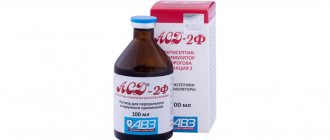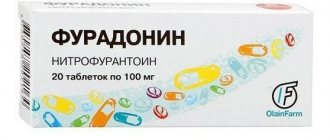Instructions for use CIPROFLOXACIN
Cardiac disorders.
Ciprofloxacin has an effect on prolonging the QT interval. Elderly patients have increased sensitivity to the effects of drugs that prolong the QT interval. Therefore, caution should be used when ciprofloxacin is used in combination with drugs that prolong the QT interval (eg, class IA and III antiarrhythmic drugs) or in patients with an increased risk of developing torsade de pointes (eg, with known QT prolongation corrected by hypokalemia).
Musculoskeletal system.
At the first signs of tendinitis (painful swelling in the joint area, inflammation), the use of ciprofloxacin should be stopped and physical activity should be avoided, because There is a risk of tendon rupture, and consult a doctor. In elderly patients with tendon diseases, or those previously treated with corticosteroids, cases of tendon rupture (mainly Achilles tendon) may occur. Ciprofloxacin should be used with caution in patients with a history of tendon diseases associated with quinolones.
Fluoroquinolones, including ciprofloxacin, may increase muscle weakness in patients with myasthenia gravis.
Use caution if you have a history of stroke; mental illness
(depression, psychosis); renal failure (also accompanied by liver failure). In some cases, adverse reactions from the central nervous system may occur after the first use of the drug. In very rare cases, psychosis can manifest itself as suicide attempts. In these cases, you should immediately stop taking ciprofloxacin and tell your doctor.
Skin covering.
Photosensitivity reactions may occur when taking ciprofloxacin, so patients should avoid contact with direct sunlight and UV light. Treatment should be discontinued if symptoms of photosensitivity are observed (for example, changes in the skin reminiscent of sunburn).
Genital tract infections.
For genital infections suspected of being caused by fluoroquinolone-resistant strains of Neisseria gonorrhoeae, local information on ciprofloxacin resistance should be taken into account and susceptibility of the pathogen should be confirmed in laboratory tests.
Cytochrome P450.
Ciprofloxacin is known to be a moderate inhibitor of CYP4501A2 isoenzymes.
Caution should be exercised during the simultaneous use of ciprofloxacin and drugs metabolized by these enzymes, such as theophylline, methylxanthine, caffeine, duloxetine, clozapine,
etc., since an increase in the concentration of these drugs in the blood serum, due to inhibition of their metabolism by ciprofloxacin, may cause specific adverse reactions .
To avoid the development of crystalluria, it is unacceptable to exceed the recommended daily dose; sufficient fluid intake and maintaining an acidic urine reaction are also necessary.
In vitro, in laboratory tests, ciprofloxacin inhibits the growth of Mycobacterium spp., which may lead to false negative results when diagnosing this pathogen in patients taking ciprofloxacin.
Patients with epilepsy, a history of seizures, vascular diseases and organic brain damage due to the risk of developing adverse reactions from the central nervous system should be prescribed ciprofloxacin only for health reasons.
If severe and prolonged diarrhea occurs during or after treatment with ciprofloxacin, the diagnosis of pseudomembranous colitis should be excluded, which requires immediate discontinuation of the drug and the appointment of appropriate treatment.
Impact on the ability to drive vehicles and operate machinery
Patients taking Ciprofloxacin should be careful when driving a car and engaging in other potentially hazardous activities that require increased attention and speed of psychomotor reactions (especially when consuming alcohol at the same time).
[chronic recurrent cystitis
Elena, Ryazan
1303 views
February 3, 2019
Hello, Doctor! The first and only time I suffered from cystitis was at the institute, 45 years ago. It started at the end of July. I took ciprofloxacin, but after a short-term improvement in my condition, pyelonephritis began. Injected with ceftriaxone, improvement. A few days later - cystitis again, levofloxacin, improvement. After another two weeks - doxycycline + vilprofen. After this treatment there was no improvement (the urine was cloudy, with a foul odor, except that the painful sensations disappeared), but the doctor deceived me, saying that the tests were normal. They did a cystoscopy, found an erosion and prescribed suppositories metronidazole (21 days) and indamethacin (10 days). Two weeks later, my anus was so severe that I could barely walk. At an appointment with the doctor on duty on Saturday, it turned out that the urologist simply deceived me, saying that everything was normal, because the leukocytes in that analysis were 80-90. Then the urologist advised me to take a test from the urogenital tract to determine sensitivity, it turned out that E. coli had colonized everything: the cervical canal, vagina, urethra. Cefepime was prescribed, but after a few days all the symptoms returned. The gynecologist was only able to prescribe bifidum bacterin suppositories. Then - again levofloxacin, again cystitis... The urologist's conclusion: antibiotics are powerless, the bacillus has colonized the entire bladder, all that remains is to protect its mucosa from the bacillus with instillations, there is no other way. With this in mind, I was admitted to the city urological center for a day hospital, but on the second day pyelonephritis began with high fever. Consultation with a gynecologist - 2 courses of tampons with coliproteus bacteriophage, then suppositories. Seven days of ceftriaxone injections, bacterial culture (on the 5th day of injections) sterile - go home. Cystoscopy and instillations - no earlier than in a month. In response to my words that remission does not last more than 4-5 days, the doctor advised me to inject Aztreon on an outpatient basis (I already looked for it in pharmacies, but they don’t even take it to order, because suppliers don’t have it.). To this the doctor briefly answered: “Look” and stopped communicating with me. Exactly 5 days after discharge, yesterday morning I woke up from a terrible pain in the hospital. Hello again, cystitis! Now I’m writing to you, but my temperature is already 38, I’m afraid I’ll end up in the hospital again. I have always respected doctors, but this epic killed me mentally - after all, we didn’t fight with a stick for almost two months... I’m in absolute shock - it turns out there is nothing to treat me with? And any pyelonephritis can be the last? After all, in these seven months, three antibiotics have already been lost to me. Please forgive me for writing in such detail, I’m just very scared.
The question is closed
No reward
The synthesis of compounds from the group of fluoroquinolones, carried out on a large scale in order to search for new antimicrobial drugs, has been carried out for over 15 years. During this period, highly effective drugs were developed from this series of chemicals, which are successfully used to treat various bacterial diseases, chlamydia, and mycoplasma infections.
Currently, fluoroquinolones are considered as an important independent group of chemotherapeutic drugs as part of the class of quinolones - DNA gyrase inhibitors, which are characterized by high clinical efficacy (including for oral use), wide indications for use and constitute a serious alternative to beta-lactam antibiotics spectrum of action.
Particularly large clinical experience has been accumulated with regard to the use of ciprofloxacin, one of the first and most active drugs of this group currently used in the clinic. Ciprofloxacin is very widely used in clinical practice in various regions of the world, exceeding in frequency of prescription all other fluoroquinolones with a similar mechanism of action. Overall, ciprofloxacin was used in 340 million, ofloxacin in 170 million, levofloxacin in 150 million, lomefloxacin in 15 million, moxifloxacin in 10 million and sparfloxacin in about 5 million patients (Bayer Materials , 2002).
To date, more than 15 fluoroquinolones have been developed. Several new active compounds of this class are undergoing extensive clinical testing, so it is advisable to provide general information characterizing the drugs of this group.
The main characteristics of the action of fluoroquinolones are as follows (V.P. Yakovlev et al., 2000):
- wide antimicrobial spectrum of action, including gram-negative and gram-positive aerobic and anaerobic bacteria, mycoplasmas, chlamydia and some protozoa;
- good penetration into the microbial cell;
- bactericidal type of action;
- high activity against microorganisms with intracellular localization;
- high activity against microorganisms resistant to other antimicrobial drugs (including multidrug-resistant strains);
- activity against strains resistant to non-fluorinated quinolones;
- inhibition of DNA gyrase (bacterial topoisomerase II) and topoisomerase IV, damage to the outer membrane of microbial cells;
- damage to microbial cells in subbacteriostatic and subbactericidal concentrations;
- suppression of the induction of exoenzymes, exotoxins, adhesive properties, reduction in the virulence of pathogenic strains (including the infected organism);
- long-term post-antibiotic effect;
- ability to eliminate plasmids.
To the above properties you can add the following:
- high degree of bioavailability;
- possibility of oral and parenteral administration;
- relatively low toxicity;
- well tolerated by patients.
The use of fluoroquinolones in pediatrics is limited due to their damaging effect on growing cartilage, therefore drugs of this group are not recommended for use by pregnant women and children under 16 years of age.
Data on the activity of ciprofloxacin against uropathogens in vitro
are presented in table 1.
The most important for medical practice is the high activity of ciprofloxacin against almost all pathogenic and opportunistic gram-negative aerobic bacteria and staphylococci. The concentrations of ciprofloxacin that are created in the blood, organs and tissues when using the drug in therapeutic doses, as a rule, exceed not only the MIC values for these microorganisms, but also bactericidal concentrations, and in vitro
correlates with the effectiveness of ciprofloxacin in the clinic. In addition, this fluoroquinolone is quite active against chlamydia and mycoplasmas. For these infections, a good therapeutic effect can be achieved by using ciprofloxacin as monotherapy.
In urological practice, extremely important importance is attached to such a microorganism as Escherichia coli. Mostly E. coli
common in outpatient practice for uncomplicated urinary tract infections (UTIs).
Figure 1 shows the spectra of uropathogens encountered during UTI in outpatient practice and various hospital departments. Thus, in acute cystitis, which is usually treated on an outpatient basis, the proportion of E. coli is 87%, and in chronic cystitis and uncomplicated pyelonephritis, which are also treated on an outpatient basis, it is 73%. A completely different picture emerges for UTIs in a hospital - in general and intensive care departments: here the proportion of E. coli is steadily decreasing, amounting to 41% and 23%, respectively. At the same time, among stationary uropathogens, pathogens from the tribe Klebsiella/Enterobacter
and
Entercoccus spp are found much more often.
, are significantly less amenable to antimicrobial chemotherapy, accounting for 7-17% and 23-25%, respectively. Other gram-negative microorganisms (P. aeruginosa, Proteus spp.) also appear.
As a result of numerous studies, it has been established that, in comparison with other fluoroquinolones, the MIC90 of ciprofloxacin for sensitive strains of E. coli
has the smallest value (Fig. 2).
These data are confirmed by research by L.S. Strachunsky (Fig. 3,). He assessed the resistance of different E. coli
in Russia for uncomplicated UTIs and came to the conclusion that the best drug for treating this type of infection is ciprofloxacin.
The most problematic pathogens in urological practice, which are difficult to treat with antibacterial therapy, include P. aeruginosa
and
Enterococcus
spp.
E.N. Padeyskaya et al. (1998) studied the inhibitory concentrations of fluoroquinolones against these microorganisms (Fig. 5,).
Ciprofloxacin is superior to all other fluoroquinolones in its activity against P. aeruginosa In both cases, rather low MIC values of ciprofloxacin were determined, which indicates the high effectiveness of this fluoroquinolone in these infections.
It is important to emphasize that ciprofloxacin remains one of the most active fluoroquinolones against gram-negative pathogens that predominate in the structure of UTI pathogens. In this indicator, it is superior to all traditionally used fluoroquinolones and is not inferior to the so-called “new” fluoroquinolones.
There are clear recommendations regarding the dosage of ciprofloxacin for the treatment of UTI (Table 2).
A very important issue is the duration of treatment with ciprofloxacin for various UTIs. These data are presented in Table 3.
Relatively recently, the Ranbaxy company (India) created a new dosage form of ciprofloxacin - Cifran OD prolonged-release tablets. This drug in a dose of 500 or 1000 mg is intended for use once a day.
There is evidence in the literature that long-acting ciprofloxacin is highly effective in the treatment of UTIs. Thus, in a controlled randomized trial that included 891 women with uncomplicated UTIs, the clinical effectiveness of ciprofloxacin (Cipro OD), prescribed at a dose of 500 mg once a day, was higher than that of ciprofloxacin (Cipro), taken 250 mg 2 times a day – 95% and 91.5%, respectively (USA, Bayer, 2002). Eradication of the pathogen when using these drugs was similar and was achieved in 94% of cases.
Another report concerns the use of long-acting ciprofloxacin at a dose of 1000 mg for complicated UTIs (USA, Bayer, 2003). In this study, the clinical effectiveness of this drug taken 1 time per day was 97% versus 94% when taking traditional ciprofloxacin, prescribed 500 mg 2 times a day. Bacteriological effectiveness (eradication of the microorganism 5-11 days after treatment) in the case of taking a prolonged drug reached 89%, and traditional ciprofloxacin - 85%.
We have our own limited experience in using Cifran OD (500 mg once a day) in the treatment of complicated UTIs. Fifteen patients were studied who had the following UTIs:
- Chronic pyelonephritis in the acute stage (complicating factors - urolithiasis, solitary kidney, benign prostatic hyperplasia, cystostomy, post-traumatic urinary incontinence, urethrointestinal fistula);
- Complicated cystitis in the acute stage (complicating factors - stress urinary incontinence, sling surgery, neurogenic bladder);
- Exacerbation of chronic prostatitis (complicating factors - benign prostatic hyperplasia, cystostomy).
The following microorganisms were isolated from the studied patients: E. coli, P. mirabilis, K. ozaenae, P. vulgaris, P. aeruginosa, Enterobacter spp., S. marcescens, S. saprophyticus.
The course of treatment was 14 days. After the therapy, all microbial cultures were eliminated.
It is important to emphasize that ciprofloxacin still occupies a leading place in the treatment of major infectious and inflammatory urological diseases (Table 4).
Ciprofloxacin is one of the few antibacterial drugs that penetrate well into the prostate gland (Table 6), so it can be actively used in the treatment of bacterial prostatitis (Table 7).
Thus, more than 10 years of experience with the use of ciprofloxacin in the clinic, including its use in many millions of patients, indicates that the effectiveness of this fluoroquinolone is practically not reduced. Ciprofloxacin also exhibits high therapeutic efficacy against bacterial UTIs.
For complicated forms of UTI that prevail in urological practice today, ciprofoloxacin should be recommended in a standard daily dose of 1000 mg (2 doses of 500 mg or 1 dose of 1000 mg Cifran OD). A dose of 500 mg per day (2 doses of 250 mg or 1 dose of 500 mg of Cifran OD 500) should be recommended for the treatment of uncomplicated UTIs. There is an emerging global trend away from the use of low doses of ciprofloxacin (2 doses of 100-125 mg per day) for acute cystitis.
Ciprofloxacin should be considered as one of the antimicrobial chemotherapeutic agents of systemic action, comparable in a number of indicators with cephalosporins of the III and IV generations, with carbapenems (imipenem, meropenem) and some aminoglycosides.
It can be hoped that the emergence of a prolonged dosage form of ciprofloxacin, which allows the drug to be taken once a day and thereby increases patient adherence to therapy, will help optimize the treatment of various infections, including UTIs, and improve the quality of life of patients.
Ciprofloxacin tablet film 250 mg pack cont cell/pack card x10
Trade name: Ciprofloxacin International name: Ciprofloxacin
Release form: film-coated tablets 0.25 g (polymer jars, blister packs)
Composition: ciprofloxacin hydrochloride 250 mg
Pharmacological group: antimicrobial agent, fluoroquinolone
Pharmacological group according to ATK: J01MA02 (Ciprofloxacin)
Pharmacological action: antimicrobial, fluoroquinolone,
Indications: Bacterial infections caused by sensitive microorganisms: respiratory tract diseases - acute and chronic (in the acute stage) bronchitis, pneumonia, bronchiectasis, cystic fibrosis, infections of the ENT organs - otitis media, sinusitis, frontal sinusitis, sinusitis, mastoiditis, tonsillitis, pharyngitis, kidney and urinary tract infections - cystitis, pyelonephritis, infections of the pelvic and genital organs - prostatitis, adnexitis, salpingitis, oophoritis, endometritis, tubular abscess, pelvioperitonitis, gonorrhea, chancroid, chlamydia, abdominal infections - bacterial infections of the gastrointestinal tract, biliary tract , peritonitis, intraperitoneal abscesses, salmonellosis, typhoid fever, campylobacteriosis, yersiniosis, shigellosis, cholera, infections of the skin and soft tissues - infected ulcers, wounds, burns, abscesses, phlegmon, bones and joints - osteomyelitis, septic arthritis, sepsis, infections on the background immunodeficiency (occurring during treatment with immunosuppressive drugs or in patients with neutropenia), prevention of infections during surgical interventions.
Dosage regimen: Orally, 0.25 g 2-3 times a day, for severe infections - 0.5-0.75 g 2-3 times a day. For urinary tract infections - 0.25-0.5 g 2 times a day, course of treatment - 7-10 days. For uncomplicated gonorrhea - 0.25-0.5 g once, when a gonococcal infection is combined with chlamydial and mycoplasma - 0.75 g every 12 hours for 7-10 days. For chancroid - 0.5 g 2 times a day for several days. For meningococcal carriage in the nasopharynx - once, 0.5 or 0.75 g. For chronic carriage of salmonella - orally, 0.25 g 4 times, course of treatment - up to 4 weeks. If necessary, the dosage can be increased to 0.5 g 3 times a day. For pneumonia, osteomyelitis - orally, 0.75 g 2 times a day. The duration of treatment for osteomyelitis can be up to 2 months. For gastrointestinal infections caused by Staphylococcus aureus - 0.75 g every 12 hours for 7-28 days. Treatment should be continued for at least 3 more days after body temperature normalizes or clinical symptoms disappear. With a glomerular filtration rate (CC 31-60 ml/min/1.73 sq.m. or serum creatinine concentration from 1.4 to 1.9 mg/100 ml), the maximum daily dose is 1 g. With a glomerular filtration rate below 30 ml/min/1.73 sq.m. m or serum creatinine concentration above 2 mg/100 ml, the maximum daily dose is 0.5 g. If the patient is undergoing hemodialysis or peritoneal dialysis, 0.25-0.5 g/day, but the drug should be taken after a hemodialysis session. For severe infections (for example, recurrent cystic fibrosis, infections of the abdominal cavity, bones and joints) caused by Pseudomonas or staphylococci, acute pneumonia caused by Streptococcus pneumoniae, and chlamydial urinary tract infections, the dose should be increased to 0.75 g every 12 hours. Tablets should be swallowed whole with a small amount of liquid after meals. When taking the tablet on an empty stomach, the active substance is absorbed faster. IV drip: infusion duration is 30 minutes at a dose of 0.2 g and 60 minutes at a dose of 0.4 g. Ready-to-use infusion solutions can be combined with a 0.9% NaCl solution, Ringer's solution and Ringer-lactate, 5 and 10% solution dextrose, 10% fructose solution, as well as a solution containing 5% dextrose solution with 0.225-0.45% NaCl solution. For uncomplicated urinary tract infections, infections of the lower respiratory tract, a single dose is 0.2 g, for complicated infections of the upper urinary tract, for severe infections (including pneumonia, osteomyelitis), a single dose is 0.4 g. If necessary, intravenous in the treatment of particularly severe, life-threatening or recurrent infections caused by Pseudomonas, staphylococci or Streptococcus pneumoniae, the dose can be increased to 0.4 g with a frequency of administration up to 3 times a day. The duration of treatment for osteomyelitis can reach up to 2 months. For chronic carriage of salmonella - 0.2 g 2 times a day, course of treatment - up to 4 weeks. If necessary, the dosage can be increased to 0.5 g 3 times a day. For acute gonorrhea - 0.1 g once. To prevent infections during surgical interventions - 0.2-0.4 g 0.5-1 hour before surgery, if the operation lasts more than 4 hours, re-administer at the same dose. Average duration of treatment: 1 day - for acute uncomplicated gonorrhea and cystitis, up to 7 days - for infections of the kidneys, urinary tract and abdominal cavity, during the entire period of the neutropenic phase - in patients with weakened body defenses, but not more than 2 months - for osteomyelitis and 7-14 days for all other infections. For streptococcal infections, due to the risk of late complications, as well as for chlamydial infections, treatment should continue for at least 10 days. In patients with immunodeficiency, treatment is carried out throughout the entire period of neutropenia. Treatment should be continued for at least 3 more days after body temperature normalizes or clinical symptoms disappear. With a glomerular filtration rate (QR 31-60 ml/min/1.73 m2 or serum creatinine concentration from 1.4 to 1.9 mg/100 ml), the maximum daily dose is 0.8 g. With a glomerular filtration rate (QR below 30 ml/min/1.73 m2 or serum creatinine concentration above 2 mg/100 ml) maximum daily dose - 0.4 g. For elderly patients, the dose is reduced by 30%. For peritonitis, it is permissible to use intraperitoneal administration of infusion solutions at a dose of 50 mg 4 times a day per 1 liter of dialysate. After IV use, you can continue treatment orally.
Contraindications: Hypersensitivity, childhood (up to 18 years - until the process of skeletal formation is completed), pregnancy, lactation.
Side effects: From the digestive system: nausea, diarrhea, vomiting, abdominal pain, flatulence, loss of appetite, cholestatic jaundice (especially in patients with previous liver diseases), hepatitis, hepatonecrosis. From the nervous system: dizziness, headache, increased fatigue, anxiety, tremor, insomnia, “nightmare” dreams, peripheral paralgesia (anomaly in the perception of pain), increased sweating, increased intracranial pressure, confusion, depression, hallucinations, etc. manifestations of psychotic reactions (occasionally progressing to states in which the patient can harm himself), migraine, fainting, thrombosis of the cerebral arteries. From the senses: disturbances of taste and smell, visual impairment (diplopia, changes in color vision), tinnitus, hearing loss. From the cardiovascular system: tachycardia, heart rhythm disturbances, decreased blood pressure. From the hematopoietic system: leukopenia, granulocytopenia, anemia, thrombocytopenia, leukocytosis, thrombocytosis, hemolytic anemia. From laboratory parameters: hypoprothrombinemia, increased activity of “liver” transaminases and alkaline phosphatase, hypercreatininemia, hyperbilirubinemia, hyperglycemia. From the urinary system: hematuria, crystalluria (primarily with alkaline urine and low diuresis), glomerulonephritis, dysuria, polyuria, urinary retention, albuminuria, urethral bleeding, hematuria, decreased nitrogen excretory function of the kidneys, interstitial nephritis. Allergic reactions: skin itching, urticaria, blistering accompanied by bleeding and the appearance of small nodules that form scabs, drug fever, pinpoint hemorrhages on the skin (petechiae), swelling of the face or larynx, shortness of breath, eosinophilia, increased photosensitivity, vasculitis, erythema nodosum, exudative erythema multiforme (including Stevens-Johnson syndrome), toxic epidermal necrolysis (Lyell's syndrome). Other: arthralgia, arthritis, tenosynovitis, tendon ruptures, asthenia, myalgia, superinfections (candidiasis, pseudomembranous colitis), “flushes” of blood to the face. Overdose. Treatment: specific antidote is unknown. It is necessary to carefully monitor the patient's condition, perform gastric lavage and other emergency measures, and ensure sufficient fluid intake. Using hemo- or peritoneal dialysis, only a small (less than 10%) amount of the drug can be removed.
Pharmacodynamics: A broad-spectrum antimicrobial agent, a fluoroquinolone derivative, suppresses bacterial DNA gyrase (topoisomerases II and IV, responsible for the process of supercoiling of chromosomal DNA around nuclear RNA, which is necessary for reading genetic information), disrupts DNA synthesis, growth and division of bacteria, causes pronounced morphological changes (including cell wall and membranes) and rapid death of the bacterial cell. It has a bactericidal effect on gram-negative organisms during the period of rest and division (since it affects not only DNA gyrase, but also causes lysis of the cell wall), on gram-positive microorganisms - only during the period of division. Low toxicity for the cells of the macroorganism is explained by the absence of DNA gyrase in them. While taking ciprofloxacin, there is no parallel development of resistance to other actibiotics that do not belong to the group of gyrase inhibitors, which makes it highly effective against bacteria that are resistant, for example, to aminoglycosides, penicillins, cephalosporins, tetracyclines and many other antibiotics. Gram-negative aerobic bacteria are sensitive to ciprofloxacin: enterobacteria (Escherichia coli, Salmonella spp., Shigella spp., Citrobacter spp., Klebsiella spp., Enterobacter spp., Proteus mirabilis, Proteus vulgaris, Serratia marcescens, Hafnia alvei, Edwardsiella tarda, Providencia spp. , Morganella morganii, Vibrio spp., Yersinia spp.), other gram-negative bacteria (Haemophilus spp., Pseudomonas aeruginosa, Moraxella catarrhalis, Aeromonas spp., Pasteurella multocida, Plesiomonas shigelloides, Campylobacter jejuni, Neisseria spp.), some intracellular pathogens - Legionella pneumophila, Brucella spp., Chlamydia trachomatis, Listeria monocytogenes, Mycobacterium tuberculosis, Mycobacterium kansasii, Corynebacterium diphtheriae, gram-positive aerobic bacteria: Staphylococcus spp. (Staphylococcus aureus, Staphylococcus haemolyticus, Staphylococcus hominis, Staphylococcus saprophyticus), Streptococcus spp. (Streptococcus pyogenes, Streptococcus agalactiae). Most staphylococci resistant to methicillin are also resistant to ciprofloxacin. The sensitivity of Streptococcus pneumoniae, Enterococcus faecalis, Mycobacterium avium (located intracellularly) is moderate (high concentrations are required to suppress them). The following are resistant to the drug: Bacteroides fragilis, Pseudomonas cepacia, Pseudomonas maltophilia, Ureaplasma urealyticum, Clostridium difficile, Nocardia asteroides. Not effective against Treponema pallidum. Resistance develops extremely slowly, since, on the one hand, after the action of ciprofloxacin there are practically no persistent microorganisms left, and on the other hand, bacterial cells do not have enzymes that inactivate it.
Pharmacokinetics: When taken orally, it is quickly and fairly completely absorbed from the gastrointestinal tract (mainly in the duodenum and jejunum). Eating slows down absorption but does not change Cmax or bioavailability. Bioavailability - 50-85%, volume of distribution - 2-3.5 l/kg, binding to plasma proteins - 20-40%. TCmax for oral administration is 60-90 minutes, Cmax linearly depends on the dose taken and is 1.2, 2.4, 4.3 and 5.4 μg/ml at doses of 250, 500, 750 and 1000 mg, respectively. 12 hours after oral administration of 250, 500 and 750 mg, the concentration of the drug in plasma decreases to 0.1, 0.2 and 0.4 mcg/ml, respectively. After IV infusion of 200 mg or 400 mg, TCmax is 60 minutes, Cmax is 2.1 and 4.6 mcg/ml, respectively. Volume of distribution - 2-3 l/kg. Well distributed in body tissues (excluding fat-rich tissue, such as nervous tissue). The concentration in tissues is 2-12 times higher than in plasma. Therapeutic concentrations are achieved in saliva, tonsils, liver, gall bladder, bile, intestines, abdominal and pelvic organs, uterus, seminal fluid, prostate tissue, endometrium, fallopian tubes and ovaries, kidneys and urinary organs, lung tissue, bronchial secretions, bone tissue, muscles, synovial fluid and articular cartilage, peritoneal fluid, skin. It penetrates into the CSF in a small amount, where its concentration in the absence of inflammation of the meninges is 6-10% of that in the blood serum, and in the case of inflammation - 14-37%. Ciprofloxacin also penetrates well into the ocular fluid, bronchial secretions, pleura, peritoneum, lymph, and through the placenta. The concentration of ciprofloxacin in blood neutrophils is 2-7 times higher than in blood serum. Activity decreases slightly at pH values less than 6. Metabolized in the liver (15-30%) with the formation of low-active metabolites (diethylciprofloxacin, sulfociprofloxacin, oxociprofloxacin, formylciprofloxacin). T1/2 - about 4 hours with oral administration and 5-6 hours with intravenous administration, with chronic renal failure - up to 12 hours. It is excreted mainly by the kidneys through tubular filtration and tubular secretion in unchanged form (when taken orally - 40-50 %, with intravenous administration - 50-70%) and in the form of metabolites (when taken orally - 15%, with intravenous administration - 10%), the rest - through the gastrointestinal tract. A small amount is excreted in breast milk. After intravenous administration, the concentration in urine during the first 2 hours after administration is almost 100 times higher than in the serum, which significantly exceeds the MIC for most pathogens of urinary tract infections. Renal clearance is 3-5 ml/min/kg, total clearance is 8-10 ml/min/kg. With chronic renal failure (creatinine clearance above 20 ml/min), the percentage of the drug excreted through the kidneys decreases, but accumulation in the body does not occur due to a compensatory increase in drug metabolism and excretion in the feces. Patients with severe renal failure (creatinine clearance below 20 ml/min/1.73 sq.m.) should be prescribed 1/2 the daily dose.
Special instructions: With simultaneous intravenous administration of ciprofloxacin and drugs for general anesthesia from the group of barbituric acid derivatives, constant monitoring of heart rate, blood pressure, and ECG is required. To avoid the development of crystalluria, it is unacceptable to exceed the recommended daily dose; sufficient fluid intake and maintaining an acidic urine reaction are also necessary. During treatment, you should refrain from engaging in potentially hazardous activities that require increased attention and speed of mental and motor reactions. Patients with epilepsy, a history of seizures, vascular diseases and organic brain lesions, due to the risk of developing adverse reactions from the central nervous system, should be prescribed ciprofloxacin only for “vital” indications. If severe and prolonged diarrhea occurs during or after treatment, the diagnosis of pseudomembranous colitis should be excluded, which requires immediate discontinuation of the drug and the appointment of appropriate treatment. If pain in the tendons or the first signs of tenosynovitis appear, treatment should be stopped (individual cases of inflammation and even tendon rupture have been described during treatment with fluoroquinolones). During the treatment period, contact with direct sunlight should be avoided. Carefully. Severe cerebral atherosclerosis, cerebrovascular accident, mental illness, epilepsy, epileptic syndrome, severe renal and/or liver failure, old age.
Interaction: Due to a decrease in the activity of microsomal oxidation processes in hepatocytes, it increases the concentration and lengthens T1/2 of theophylline (and other xanthines, such as caffeine), oral hypoglycemic drugs, indirect anticoagulants, and helps reduce the prothrombin index. When combined with other antimicrobial drugs (beta-lactam antibiotics, aminoglycosides, clindamycin, metronidazole), synergism is usually observed; it can be successfully used in combination with azlocillin and ceftazidime for infections caused by Pseudomonas spp., with mezlocillin, azlocillin and other beta-lactams antibiotics - for streptococcal infections, with isoxazolepenicillins and vancomycin - for staphylococcal infections, with metronidazole and clindamycin - for anaerobic infections. It enhances the nephrotoxic effect of cyclosporine, there is an increase in serum creatinine; in such patients it is necessary to monitor this indicator 2 times a week. When taken simultaneously, it enhances the effect of indirect anticoagulants. Oral administration together with Fe-containing drugs, sucralfate and antacid drugs containing Mg2+, Ca2+ and Al3+ leads to a decrease in the absorption of ciprofloxacin, so it should be prescribed 1-2 hours before or 4 hours after taking the above drugs. NSAIDs (excluding ASA) increase the risk of seizures. Didanosine reduces the absorption of ciprofloxacin due to the formation of complexes with it with the Al3+ and Mg2+ contained in didanosine. Metoclopramide accelerates absorption, which leads to a decrease in the time to reach its Cmax. Co-administration of uricosuric drugs leads to a slower elimination (up to 50%) and an increase in plasma concentrations of ciprofloxacin. The infusion solution is pharmaceutically incompatible with all infusion solutions and drugs that are physicochemically unstable in an acidic environment (pH of the ciprofloxacin infusion solution is 3.9-4.5). Do not mix the solution for intravenous administration with solutions having a pH greater than 7.
Drug registration number: P No. 003190/01
Date of registration (re-registration) of the drug: 01/19/2004





